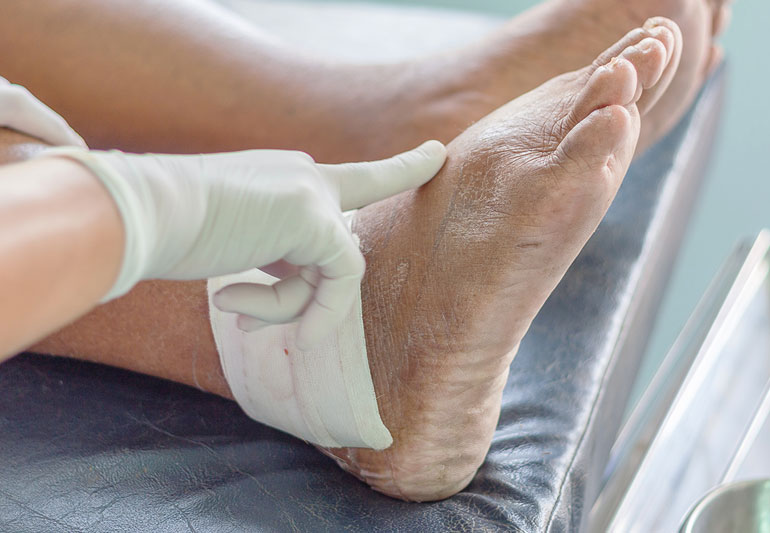An excess of uric acid in the body can accumulate in different parts of the body, such as the joints, kidneys, or soft tissues, producing gout. Discover its phases and drugs, habits, and diet to control its symptoms.
The drop is a syndrome characterized by repeated episodes of joint pain and swelling. It arises from the deposit of uric acid or urate crystals in the joints, preferably in the lower ones of the body. Inevitably this deposition of uric acid crystals is a consequence of hyperuricemia or high blood levels in the blood.
Uric acid is a waste product from the decomposition of purines, typically found in small amounts in urine. If there is an excess of uric acid in the body, it can accumulate in different body parts such as the joints, kidneys, or soft tissues. If it accumulates in the joints, specifically in the synovial fluid, uric acid crystals are formed, which are responsible for inflammation and swelling. It is important to clarify that an individual with hyperuricemia (high uric acid levels in the blood) does not necessarily have to develop gout disease.
The most frequently affected points by this type of arthritis are the lower areas of the body, ankles, feet (especially the big toes), and knees, but it also attacks the hands and wrists.
Gout is a more common disease in men, with a low incidence of 0.3%, although around 2%. In isolation, hyperuricemia has a prevalence of 6-7%. This explains that high urate levels do not always lead to gout. This incidence is directly related to uric acid levels so that it reaches 5% for blood uric acid levels above 9 mg/dl. Likewise, this incidence increases in parallel with age, being more frequent after the fifth decade of life.
If hyperuricemia is corrected, the deposits slowly dissolve until disappearing. Therefore, it is considered a reversible disease. If this does not happen, uric acid overload persists. Over time, it becomes chronic, and nodules form around the joint known as tophi.
Causes of gout
Let’s talk about the causes of gout. The fact that the body has an increase in uric acid may be due to two circumstances: either the body itself generates an excess of the compound or cannot eliminate it correctly. That is, there is some kidney failure. These circumstances may be caused by one or more of these factors:
- Blood diseases: some blood diseases can cause this disease, such as myeloproliferative syndromes, leukemias, lymphomas, polycythemia vera, and so on.
- Some oncological diseases and their treatments can also cause high uric acid and gout levels, so at the beginning of chemotherapy sessions, this must be taken into account and prevented.
- Drugs: so-called cytostatics, drugs mostly used to treat cancer, can trigger this syndrome. Some drugs for the treatment of the AIDS virus can also cause episodes of gout. And some diuretics have also been related to this mechanism.
- Diet: it is a factor well known as a producer of hyperuricemia and gout. Historically, this disease was related to kings and nobles, who at the time were the only ones with access to meats and foods rich in purines, as well as alcoholic beverages such as beer (they often used to abuse their consumption), which increase the risk of suffering the illness. Today this factor continues to make it more common in the Western world.
- Failure to eliminate uric acid: all these mentioned causes favor hyperuricemia and gout, generally due to an increase in uric acid production in the blood. Another small percentage of patients may present with gout and hyperuricemia due to a defect in eliminating this substance. This group is worth highlighting chronic kidney failure as the most common, and others, such as lead poisoning, more rarely.
- Genetics: there is a hereditary factor, so that individuals with a genetic predisposition must be especially careful when committing excesses with foods such as seafood, red meat, pork, certain fish, etc. All these foods have the common characteristic of being rich in purines; when metabolized by the body, uric acid rises. In these people with familial involvement, the mechanism is usually a defect in the renal elimination of uric acid.
- Being male: men, in general, are more susceptible to suffering from the disease; in the case of women, gout tends to appear, especially after menopause.
- Comorbidities: it is relatively common for people with certain chronic diseases also to develop gout. Some of the most common pathologies related to this ailment are obesity, diabetes, hyperlipidemia (increased fat in the blood), kidney disorders, leukemia, and certain types of anemia.

